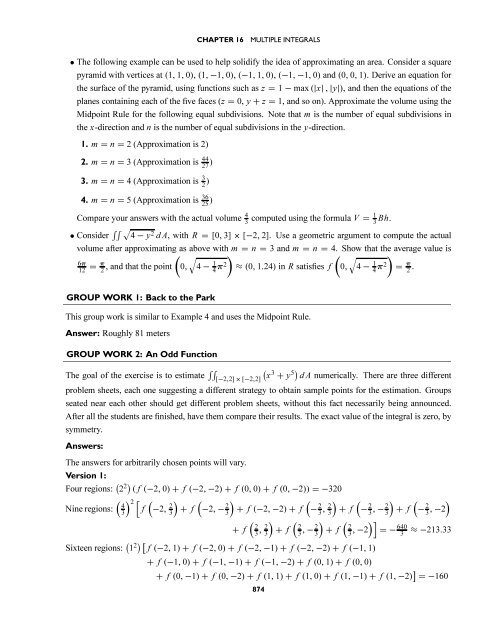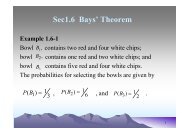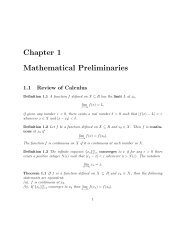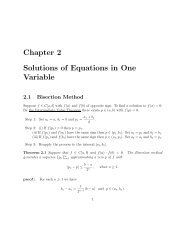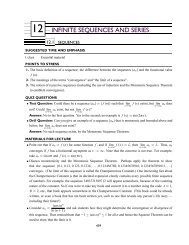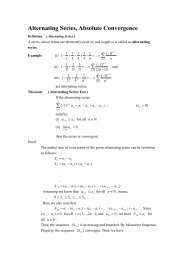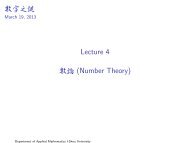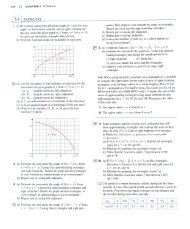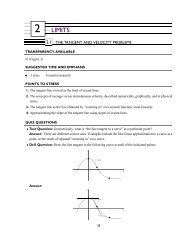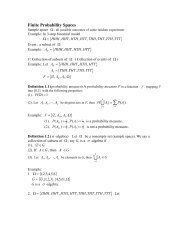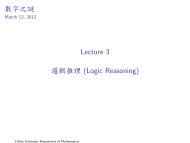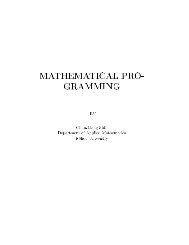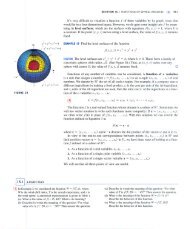16 MULTIPLE INTEGRALS
16 MULTIPLE INTEGRALS
16 MULTIPLE INTEGRALS
Create successful ePaper yourself
Turn your PDF publications into a flip-book with our unique Google optimized e-Paper software.
CHAPTER <strong>16</strong><br />
<strong>MULTIPLE</strong> <strong>INTEGRALS</strong><br />
• The following example can be used to help solidify the idea of approximating an area. Consider a square<br />
pyramid with vertices at (1, 1, 0), (1, −1, 0), (−1, 1, 0), (−1, −1, 0) and (0, 0, 1). Derive an equation for<br />
the surface of the pyramid, using functions such as z = 1 − max (|x| , |y|), and then the equations of the<br />
planes containing each of the five faces (z = 0, y + z = 1, and so on). Approximate the volume using the<br />
Midpoint Rule for the following equal subdivisions. Note that m is the number of equal subdivisions in<br />
the x-direction and n is the number of equal subdivisions in the y-direction.<br />
1. m = n = 2(Approximationis2)<br />
2. m = n = 3(Approximationis 44<br />
27 )<br />
3. m = n = 4(Approximationis 3 2 )<br />
4. m = n = 5(Approximationis 36<br />
25 )<br />
Compare your answers with the actual volume 4 3 computed using the formula V = 1 3 Bh.<br />
• Consider ∫∫ √<br />
4 − y 2 dA,withR = [0, 3] × [−2, 2]. Use a geometric argument to compute the actual<br />
volume after approximating as above with m = n = 3andm = n = 4. Show that the average value is<br />
)<br />
(<br />
)<br />
6π<br />
12<br />
= π 2<br />
(0,<br />
√4 , and that the point − 1 4 π2 ≈ (0, 1.24) in R satisfies f 0,<br />
√4 − 1 4 π2 = π 2 .<br />
GROUP WORK 1: Back to the Park<br />
This group work is similar to Example 4 and uses the Midpoint Rule.<br />
Answer: Roughly 81 meters<br />
GROUP WORK 2: An Odd Function<br />
The goal of the exercise is to estimate ∫∫ (<br />
[−2,2] × [−2,2] x 3 + y 5) dA numerically. There are three different<br />
problem sheets, each one suggesting a different strategy to obtain sample points for the estimation. Groups<br />
seated near each other should get different problem sheets, without this fact necessarily being announced.<br />
After all the students are finished, have them compare their results. The exact value of the integral is zero, by<br />
symmetry.<br />
Answers:<br />
The answers for arbitrarily chosen points will vary.<br />
Version 1:<br />
Four regions: ( 2 2) ( f (−2, 0) + f (−2, −2) + f (0, 0) + f (0, −2)) =−320<br />
( ) 2 [ ( ) ( )<br />
( ) (<br />
Nine regions: 43<br />
f −2, 2 3<br />
+ f −2, − 2 3<br />
+ f (−2, −2) + f − 2 3 , 2 3<br />
+ f − 2 3 , − 2 3<br />
( ( (<br />
+ f 23<br />
, 3)<br />
2 + f 23<br />
, − 3)<br />
2 + f 23<br />
, −2)]<br />
)<br />
)<br />
+ f<br />
(− 2 3 , −2<br />
=− 640<br />
3 ≈−213.33<br />
Sixteen regions: ( 1 2)[ f (−2, 1) + f (−2, 0) + f (−2, −1) + f (−2, −2) + f (−1, 1)<br />
+ f (−1, 0) + f (−1, −1) + f (−1, −2) + f (0, 1) + f (0, 0)<br />
+ f (0, −1) + f (0, −2) + f (1, 1) + f (1, 0) + f (1, −1) + f (1, −2) ] =−<strong>16</strong>0<br />
874


